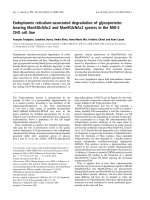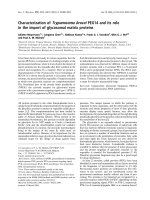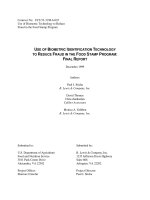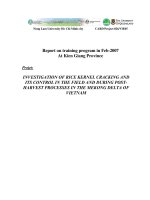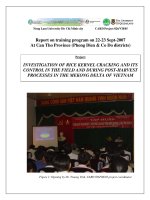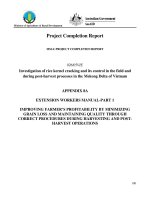OCEANOGRAPHIC PROCESSES OF CORAL REEFS: Physical and Biological Links in the Great Barrier Reef - Chapter 18 docx
Bạn đang xem bản rút gọn của tài liệu. Xem và tải ngay bản đầy đủ của tài liệu tại đây (306.84 KB, 13 trang )
The Sea Surface
Temperature Story on the
Great Barrier Reef during
the Coral Bleaching Event
of 1998
William Skirving and John Guinotte
CONTENTS
Introduction . . . . . . . . . . . . . . . . . . . . . . . . . . . . . . . . . . . . . . . . . . . . . . . . . . . . . . 301
Water Movement within the GBR. . . . . . . . . . . . . . . . . . . . . . . . . . . . . . . . . . . . . 304
GBR Weather and SST during February 1998 . . . . . . . . . . . . . . . . . . . . . . . . . . . 305
The 3-Day Averaged SST . . . . . . . . . . . . . . . . . . . . . . . . . . . . . . . . . . . . . . . . . . . 306
The Central and Northern GBR Story . . . . . . . . . . . . . . . . . . . . . . . . . . . . . . 306
The Southern GBR Story . . . . . . . . . . . . . . . . . . . . . . . . . . . . . . . . . . . . . . . . 307
Discussion . . . . . . . . . . . . . . . . . . . . . . . . . . . . . . . . . . . . . . . . . . . . . . . . . . . . . . . 307
Conclusion. . . . . . . . . . . . . . . . . . . . . . . . . . . . . . . . . . . . . . . . . . . . . . . . . . . . . . . 308
References . . . . . . . . . . . . . . . . . . . . . . . . . . . . . . . . . . . . . . . . . . . . . . . . . . . . . . . 308
INTRODUCTION
The Great Barrier Reef (GBR) experienced its most intensive and extensive coral
bleaching event on record in early 1998 (Berkelmans & Oliver, 1999). Bleaching
occurs when there is widespread loss of pigment from coral, due mainly to the expul-
sion of symbiotic algae (Yonge & Nicholls, 1931). The algae are usually expelled in
times of stress, often caused by sea surface temperatures (SST) which are higher than
the coral colony’s tolerance level. This may be as little as 1 to 2°C above the mean
monthly summer values (Glynn et al., 1988; Drollet et al., 1994; Berkelmans
& Willis, 1999). Other causes of stress are above-average amounts of solar radiation,
high turbidity, and low salinity. Generally, high SSTs and high levels of solar radia-
tion go hand in hand, and are occasionally accompanied by low tides.
18
301
© 2001 by CRC Press LLC
Although most of these causes have been implicated at some sites for the
1998 mass bleaching event, the main cause has been identified as elevated SST. The
occurrence of bleaching at many locations was patchy, with more severe bleaching
recorded in shallow waters than at deeper offshore sites. Corals can recover from
bleaching but death may result if environmental stresses are extreme and/or pro-
longed (Done & Whetton, 1999).
There is concern that widespread death and bleaching of corals may occur more
frequently in the GBR region if global climate change unfolds as expected during the
21st century (Done & Whetton, 1999).
The need for accurate environmental monitoring techniques that are of use
in monitoring coral bleaching is of utmost importance among coral reef researchers.
The National Oceanic and Atmospheric Administration (NOAA) National
Environmental Satellite, Data, and Information Service (NESDIS) has gone some
way toward developing a useful tool with their “coral bleaching hot spot” maps.
These maps are developed from NOAA AVHRR data and are provided via the
Internet at 50 km resolution. A current version of this product can be seen at
:8080/PSB/EPS/SST/climo&hot.html.
The “hot spot” maps show temperature anomalies, which are derived by sub-
tracting recent images from a “satellite only” 25-year climatology. The “daily” cli-
matology used, an interpolation of the two monthly climatologies closest in time, the
July 30, 1999 anomaly chart, was calculated by linearly interpolating the July and
August climatologies. This “daily” climatology is subtracted from the operational 50-
km SST analysis to produce the July 30 SST anomaly chart labeled 7.30.1999. For a
complete description of the process see :8080/PSB/
EPS/SST/climodoc.html.
This “hot spot” analysis seemed to provide a useful tool for monitoring the onset
of the GBR bleaching in 1998. An animation of the progress of the 1998 anomaly
through the bleaching period can be found at :8080/
PSB/EPS/SST/data/ane98e.gif. The onset of the bleaching in early February 1998
seemed to be predicted by the hot spot anomaly for 31 January, 1998 (Figure 1).
However, there are resolution problems. The resolution of 50 km and the use of
monthly averages do not allow the complete bleaching story to be told. Figure 2 is an
SST map we produced at 1 km spatial resolution using the NOAA non-linear SST
(NLSST) algorithm. The NLSST is NOAA’s current operational SST algorithm.
Overlaid on this image are the results of a coral bleaching intensity map produced by
Berkelmans and Oliver (1999). This figure shows in detail the spatial variability in
the SST and the bleaching and the correlation between these. This is not apparent in
the 50-km NOAA hot spot map (Figure 1). Furthermore, Figure 1 is a snapshot on 31
January, 1998, whereas Figure 2 is a composite for 4 to 5 February, 1998, almost a
week later. Figure 3 is the same NOAA 50-km temperature anomaly product as
shown in Figure 1, but for 7 February, 1998. This image does not match the broad-
scale spatial variation of SST, depicted in Figure 2, as does the hot spot product for
31 January, 1998. The NOAA NESDIS product requires better spatial and temporal
scales to be of significant use for monitoring of coral reef bleaching events in the
GBR region.
302 Oceanographic Processes of Coral Reefs
© 2001 by CRC Press LLC
Figure 2 shows that the severity of bleaching is highly correlated with the
AVHRR SST local area coverage (LAC) product. This is due to the fact that the corals
have thermal thresholds (Berkelmans & Willis, 1999). After their threshold has been
reached then they are likely to bleach. The problem with these thresholds is that they
are not well understood. It is known that they vary between species and between dif-
ferent geographic sites (Berkelmans & Willis, 1999). An accurate satellite-derived
SST product would be invaluable for studying bleaching.
The NOAA NLSST algorithm is employed operationally by NESDIS and is con-
sidered to be one of the most accurate algorithms to date (Barton, 1995). This algo-
rithm is designed to provide an estimate of the SST value at a depth of 1 m, from
AVHRR data. When applied to the GBR region, the NLSST algorithm slightly under-
estimates the bulk temperature below about 27°C, and significantly overestimates the
bulk temperature above this temperature (Figure 4). The overall rms value is 0.82°C.
Figure 5 shows the time series of temperature between 1 September, 1997 and 30
December, 1998 for Kelso Reef (80 km north of Townsville). Note that the NLSST
algorithm significantly overestimates the bulk temperature for temperatures above
29.5°C (indicated by the dashed line). The first section of temperatures over 29.5°C
in Figure 5 represents the coral bleaching period of 1998 (around day 450).
The reasons for the NLSST algorithm overestimation of temperatures are easily
explained for the GBR region. SSTs in excess of 30°C mostly occur during periods
of cloudless days with light winds. The lack of cloud allows the sun to heat up the
upper few centimeters of the sea surface. The wind-induced mixing would normally
mix the cooler, deeper waters with the warmer surface, thus distributing the heat
through the water column rather than allowing it to be concentrated at the surface. A
lack of mixing creates a stratified water column within the first few tens of centime-
tres of the surface, making the skin temperature atypically higher than the tempera-
ture at a depth of 1 m (the depth at which the NLSST is tuned). Yokoyama et al.
(1995) described similar effects on satellite SSTs in Mutsu Bay, Japan.
Typically, the skin temperature (that measured by the satellite) will be between
0 and 0.5°C cooler than the temperature at a depth of 1 m (Wick et al., 1992). This is
due to two mechanisms. The “skin effect” (Saunders, 1967; Mobasheri, 1995) is the
term associated with a cool skin due to loss of heat via the process of evaporation.
The second mechanism is due to wind waves, which are the main mechanism for mix-
ing within the top few metres of the sea surface (Massel, 1996). Wave-induced mix-
ing decreases the temperature gradient through the first metre of water (Mobasheri,
1995). By not explicitly taking account of these two effects in the NLSST, Walton
et al. (1998) effectively built an average temperature gradient into their algorithm
based on the average amount of mixing and evaporation implicit in the ground truth
data used to derive the algorithm. Whereas this is not a bad assumption to make for a
global algorithm, it is the main reason for the poor performance of the NLSST in the
GBR region during the 1998 coral bleaching event.
The performance of the NLSST algorithm can be seen in Figure 6. The rms error
of the one-to-one line is 0.83°C. This error can be decreased to 0.7°C if we fit a least-
squares’ linear function to the data. Although this is only a modest improvement, it
will greatly improve the SST estimates above 30°C. This function can be used as a
The Sea Surface Temperature Story on the Great Barrier Reef 303
© 2001 by CRC Press LLC
“regional fix” for NLSST-derived SST values for the GBR. The function is
Y ϭ 4.55 ϩ 0.79 X, R
2
ϭ 85.1%, ϭ0.70°C (1)
where Y is the corrected SST and X is the AVHRR SST derived with the use of the
NLSST.
In an attempt to improve on the accuracy of the NLSST, we derived a new SST
algorithm for the GBR. This is a skin SST algorithm which overcomes the problems
of the skin/bulk temperature variations by avoiding its use in the first instance. The
new algorithm is
SST ϭ A ϩ B bt4 ϩ C bt45 ϩ D (bt45)
2
(2)
where A ϭ 9.21083 Ϫ 6.74323 sec
ϩ 9.09126 (sec
)
2
B ϭ 0.9676 ϩ 0.02535 sec
Ϫ 0.0292 (sec
)
2
C ϭ 1.1246 ϩ 0.3183 sec
Ϫ 0.228 (sec
)
2
D ϭϪ0.22123 ϩ 0.73108 sec
Ϫ 0.35553 (sec
)
2
ϩ 0.06464 (sec
)
3
bt4 is the brightness temperature of AVHRR channel 4.
bt45 is the difference between AVHRR channels 4 and 5.
is the satellite look angle as measured at the surface.
This algorithm uses AVHRR channels 4 and 5 to derive a skin SST, and is applic-
able to the GBR. Without testing, it would not be wise to assume that this algorithm
will be accurate outside this region.
Figure 7 shows a plot of the results of this algorithm against data collected on
board a ferry, just north of Townsville, over a period of 2 years. This algorithm has
an rms error of 0.4°C when compared to the radiometer data. This is a significant
improvement on the NLSST performance. The difference between these two errors
associated with each of the algorithms can be largely explained by the variation in the
skin/bulk temperature difference.
The skin/bulk temperature difference is not well correlated with SST, but is
likely to be explained via the two main mixing mechanisms, wind and tidal currents.
Future work is being directed toward relating the skin SST (derived using their
AVHRR regional skin algorithm) to the bulk water temperature with the use of local
wind and tide data.
Until this work is complete, the best method for deriving bulk SSTs for the GBR
from the NOAA AVHRR sensor is the NOAA NLSST algorithm with the “regional
fix” applied.
WATER MOVEMENT WITHIN THE GBR
In gaining an insight into the causes of the 1998 GBR bleaching event, first an under-
standing of the mechanisms which cause water movement, both vertical (mixing) and
horizontal (advection), is necessary. Vertical exchange of water due to turbulence
304 Oceanographic Processes of Coral Reefs
© 2001 by CRC Press LLC
causes the cooler bottom waters to become mixed with the warmer upper waters,
effectively distributing the heat throughout the water column and thus cooling the sea
surface. When currents circulate around reefs, the secondary circulation around reefs
provides an efficient mechanism for mixing the cooler bottom waters with the
warmer top waters in and around the reefs (Wolanski et al., 1996).
Horizontal movement, or advection of water by currents, is an important mech-
anism for moving hot or cold water from its place of origin to another geographic
location. The water circulation within the GBR is affected by the wind, the tides, and
by the East Australian Current (EAC) and the Hiri Current (Andrews & Clegg, 1989).
The latter are western boundary currents, flowing, respectively, southward and north-
ward, and are a result of the bifurcation of the South Equatorial Current as it is
deflected by the Australian continent between latitude 14 and 18°S (Church, 1987;
Andrews & Clegg, 1989; Burrage, 1993). The exact location of the bifurcation point
varies seasonally and also inter-annually. These low frequency currents exert most of
their influence over the waters of the outer shelf (Wolanski, 1994; Burrage et al.,
1996; also see Spagnol et al., Chapter 14, this book).
Tidal currents vary in strength along the length of the GBR (King & Wolanski,
1996). The tides in the northern and central GBR have ranges of up to about 3.5 m,
whereas the southern GBR is a region of macro tides, parts of which experience tidal
ranges exceeding 6 m (Wolanski, 1994).
The most influential forcing mechanism, on time scales of 2 to 20 days, for cur-
rents within the GBR lagoon is the wind (Wolanski & Thomson, 1984; Burrage et al.,
1991; Wolanski, 1994). During the winter (the dry season) the dominant winds are
the southeast trades, which can create a northward current over the shelf. During the
summer monsoon, the winds can be more fickle. In general the wind-induced cur-
rents north of the monsoon trough will have a southward component and those south
of the trough will have a northward component.
GBR WEATHER AND SST DURING FEBRUARY 1998
Since the beginning of instrumental records in 1856, 1998 was the warmest year on
record (Karl et al., 2000; also see Lough, Chapter 17, this book). Clearly the highest
SSTs occurred during February 1998, as can be seen in Animation 1, which shows
monthly satellite-derived SST for the GBR between January 1997 and December
1999.
In the northern GBR region (north of the Whitsunday Islands) the majority
of bleaching occurred during the first week of February 1998. Between 1 and 5
February, 1998, low winds and neap tides (Figure 8) combined to create a period of
little to no mechanical mixing of the top few metres of water. These conditions, when
combined with little or no cloud, allow the sun to efficiently heat up the top few
metres of water to remarkably high temperatures. In the absence of significant verti-
cal mixing, this results in a stratified temperature structure. This layer will continue
to get hotter until the layer is mixed with cooler bottom waters as a result of wind
and/or tidal mixing processes.
The Sea Surface Temperature Story on the Great Barrier Reef 305
© 2001 by CRC Press LLC
This almost happened again during the next set of neap tides (2 weeks later),
however the lull in the wind was for a considerably shorter period and the low winds
and neap tides did not align themselves quite as well as they did earlier in February.
THE 3-DAY AVERAGED SST
We shall now concentrate on the period between 25 January and 21 February, 1998.
The following three sections will make use of animations based on 3 days running
means of satellite SST images. These images are derived from AVHRR LAC data
(Advanced Very High Resolution Radiometer, Local Area Coverage).
Animation 2 shows the SST distribution for this period. There are three main fea-
tures to be drawn from this animation. Firstly, there were two separate regions of hot
water genesis, one near Townsville and the other south of Mackay. Secondly, the tim-
ing, growth, and movement of these two hot water masses differed. Lastly, the south-
ern Whitsunday Islands (adjacent to Proserpine) remained relatively cool throughout
the bleaching period. Possible reasons for this will be examined later.
There appears to be a separate story concerning the water which caused bleach-
ing in the central and northern GBR as opposed to the story in the southern GBR. As
a result, these two regions will be examined separately.
THE CENTRAL AND NORTHERN GBR STORY
Animation 3 shows the distribution of 3-day averages of satellite SSTs for the GBR
north of the Whitsunday Islands between 25 January and 21 February, 1998. Figure 8,
showing the tidal range and wind speed, has been imbedded into this animation. A red
bar has been positioned over the imbedded graph which indicates the central date asso-
ciated with the 3-day average for each frame of the animation. The date associated with
the 3-day animation is also indicated at the top of the key in the lower left of the screen.
As shown in Animation 3, the beginning of the warm period corresponded to
2 to 4 February, when both the wind and tidal range were at a minimum. This repre-
sents a period of little to no mixing and maximum heating (no cloud). Immediately
following this period, the wind and tides increased the mixing, and the skin temper-
ature (the temperature sensed by the satellite) cooled down as the cooler bottom
waters were mixed with the warm upper water. By 7 February, the wind speed had
reached a maximum and the tidal range had increased. This increased vertical mix-
ing and resulted in a minimum for water temperatures. This period of high average
winds was characterized by strong winds from the southeast intertwined with periods
of low winds with a more easterly direction. These strong winds generated a north-
ward coastal current. This current took some time to generate and manifests itself in
Animation 3 after a few days when the hot water around Innisfail was advected north-
ward along the coast and past Cairns toward Port Douglas. The end of this advection
corresponded to a period of lower winds, providing the mechanism for another period
of high surface temperature.
By 14 February, the winds had picked up again, cooling the surface waters. The
period around 16 February had the potential to cause the most bleaching of this entire
period. The wind speed and tidal range were smaller than during the initial hot water
306 Oceanographic Processes of Coral Reefs
© 2001 by CRC Press LLC
period around 3 and 4 February. However, due to cloud cover, significant amounts of
direct solar heating were missing. This saved the reef from record high temperatures.
This cloudy period marked the end of the bleaching event in GBR north of the
Whitsunday Islands.
THE SOUTHERN GBR STORY
The story in the southern GBR, south of the Whitsunday Islands, was somewhat dif-
ferent to that of the north. There was considerably more cloud cover throughout this
winds and tidal range for this region between 25 January and 21 February, 1998. The
initial low in wind speeds occurred 1 day earlier than it does in the northern region,
creating a slight mismatch with the neap tides which occurred on 3 February. This
meant that the mixing depth would have been deeper through this initial warming
period than it was in the northern region. Cloud amounts in the southern region were
also still quite high, preventing any significant heating. Consequently, during the ini-
tial bleaching period in the northern region, water temperatures in the southern sec-
tion were considerably lower than in the north.
After this period of low wind, the winds picked up substantially and the mixing
was another period of low winds only a week later, but unlike the northern section,
this coincided with a maximum in the tidal range in the south, effectively maintain-
ing mixing and preventing any significant heating.
Animation 4 demonstrates that the major heating period for the southern GBR
was between 15 and 17 February, during which time the winds and tidal range were
sufficiently low during a period of relatively low cloud cover.
DISCUSSION
The SST stories during the 1998 coral bleaching event in the GBR demonstrate the
importance of mixing. The wind waves, when they occurred, appeared to cool the
water surface and prevent bleaching.
The tidal currents also were important in decreasing surface temperature. These
currents vary in strength along the length of the GBR, with the strongest currents in
the south. North of the Whitsundays Islands, the tidal currents associated with neap
tides were small enough to create no discernable mixing. This is demonstrated in
reefs was the same as in the surrounding waters. This can only happen if there was
negligible mixing.
The same was not the case for the southern GBR where the tides are much larger.
Even during neap tides, the tidal excursion remains considerable. The effect of this is
for the waters around reefs in this region to be well mixed, as is shown in Figure 9.
This image suggests tide-induced mixing, because the temperatures in the waters sur-
rounding the southern GBR were high (exceeding bleaching thresholds), whilst the
waters in and around the reefs were considerably cooler. This suggests that the tide-
induced mixing enabled these reefs to escape bleaching during this period.
The Sea Surface Temperature Story on the Great Barrier Reef 307
© 2001 by CRC Press LLC
whole period, as can be seen in Animation 18.4. This animation also shows a plot of
process cooled the surface waters (Animation 4). As with the northern region, there
Animation 3 during neap tides, when the temperature of the water over and near the
To illustrate the importance of tide-induced mixing, we will focus on a cross-shelf
transect in the northern part of this region. Figure 10 shows details of the SST distrib-
ution, while the bathymetry for this same region is shown in Figure 11. Figure 12 is
the plot of depth and SST along a cross-shelf transect. This figure shows that the SSTs
were highest in deep water and lowest in shallow water in and around the reefs. This
is a striking demonstration of how the tides create mixing around the reefs.
Figure 9 also suggests that isolated reefs are vulnerable to bleaching, while reefs
in the wake of others may benefit from the mixing that occurred around the leading
reef. Indeed, the reefs around the Capricorn Bunker Group (southeast of
Rockhampton, in Figure 9) are an example of this. The outside reefs were severely
bleached whilst the middle reefs were only moderately bleached.
Lastly, the southern Whitsunday Islands seemed to escape bleaching due to a
combination of mixing due to the interaction of the tidal currents with the many
islands in the region and considerably more clouds than most other parts of the GBR
(Animation 4).
CONCLUSION
The GBR bleaching event during 1998 was caused by a coincidence of three local
variables: neap tides, low winds, and clear skies. These conditions were not all that
unusual and could have happened at any time in the past, and will definitely happen
again. The link to climate is not clear. Global warming may provide the conditions
for these three variables to coincide more frequently in the future and hence cause
more bleaching more often.
During the GBR 1998 bleaching event, bleaching only occurred in the absence
of mixing. In all bleaching cases, the winds were low. Many reefs seemed to escape
the bleaching temperatures by interacting with the tidal currents to induce vertical
mixing and hence cool the hot surface waters by mixing them with the cooler lower
waters.
Based on the 1998 bleaching event, it would appear that some reefs are less
likely to bleach due to their exposure to strong currents. Clearly, processes of mixing
around reefs deserve further detailed investigation.
REFERENCES
Andrews, J.C. & Clegg, S. 1989 Coral Sea circulation and transport deduced from modal infor-
mation models. Deep-Sea Research 36, 957–974.
Barton, I.J. 1995 Satellite-derived sea surface temperatures: current status. Journal of
Geophysical Research 100, 8777–8790.
Berkelmans, R. & Oliver, J.K. 1999 Large scale bleaching of corals on the Great Barrier Reef.
Coral Reefs 18, 55–60.
Berkelmans, R. & Willis, B.L. 1999 Seasonal and local spatial patterns in the upper thermal
limits of corals on the inshore Central Great Barrier Reef. Coral Reefs 18, 219–228.
Burrage, D.M. 1993 Coral Sea currents. Coralla 17, 135–145.
308 Oceanographic Processes of Coral Reefs
© 2001 by CRC Press LLC
Burrage, D.M., Church, J.A., & Steinberg, C.R. 1991 Linear systems analysis of momentum
on the continental shelf and slope of the central Great Barrier Reef. Journal of
Geophysical Research 96, 22, 169–190.
Burrage, D.M., Steinberg, C.R., Skirving, W.J., & Kleypas, J.A. 1996 Mesoscale circulation
features of the Great Barrier Reef region inferred from NOAA satellite imagery. Remote
Sensing of the Environment 56, 21–41.
Church, J.A. 1987 East Australian Current adjacent to the Great Barrier Reef. 1987 Australian
Journal of Marine Freshwater Research 38, 671–683.
Done, T.J. & Whetton, P.H. 1999 Climate Change and Coral Bleaching on the Great Barrier
Reef. Report to the Queensland Department of Natural Resources, Brisbane, Queensland.
Drollet, J.H., Faucon, M., Maritorena, S., & Martin, P.M.V. 1994 A survey of environmental
physico-chemical parameters during a minor coral mass bleaching event in Tahiti in 1993.
Australian Journal of Marine Freshwater Research 45, 1149–1156.
Glynn, P.W., Cortes, J., Guzman, H.M., & Richmond, R.H. 1988 El Niño (1982–83) associ-
ated coral mortality and relationship to sea surface temperature deviations in the tropical
eastern Pacific. Proceedings 6th International Coral Reef Symposium, Townsville,
Australia, 3, 237–243.
King, B. & Wolanski, E. 1996 Tidal current variability in the central Great Barrier Reef.
J. Marine Systems 9, 187–202.
Massel, S.R. 1996 Ocean Surface Waves: Their Physics and Prediction. Advanced Series on
Ocean Engineering, Vol. 11, World Scientific Publishing Co., Singapore, 491 pp.
Mobasheri, M.R. 1995 Heat Transfer in the Upper Layer of the Ocean with Application to the
Correction of Satellite Sea Surface Temperature. Ph.D. thesis, James Cook University of
North Queensland, Townsville, 182 pp.
Saunders, P.M. 1967 The temperature at the ocean-air interface. Journal Atmospheric Sciences
24, 269–273.
Walton, C.C., Pichel, W.G., & Sapper, J.F. 1998 The development and operational application
of nonlinear algorithms for the measurement of sea surface temperatures with the NOAA
polar-orbiting environmental satellites. Journal of Geophysical Research 103,
27,999–28,012.
Wick, G.A., Emery, W.J., & Schluessel, P. 1992 A comprehensive comparison between satel-
lite-measured skin and multichannel sea surface temperature. Journal of Geophysical
Research 97, 5569–5595.
Wolanski, E. 1994 Physical Oceanographic Processes of the Great Barrier Reef. Marine
Science Series, CRC Press, Boca Raton, FL, 194 pp.
Wolanski, E. & Thomson, R.E. 1984 Wind-driven circulation on the northern Great Barrier
Reef continental shelf in summer. Estuarine, Coastal and Shelf Science 18, 271–289.
Wolanski, E., Asaeda, T., Tanaka, A., & Deleersnijder, E. 1996 Three-dimensional island
wakes in the field, laboratory experiments and numerical models. Continental Shelf
Research 16, 1437–1452.
Yokoyama, R., Tanba, S., & Souma, T. 1995 Sea surface effects on the sea surface temperature
estimation by remote sensing. International Journal of Remote Sensing 16, 227–238.
Yonge, C.M. & Nicholls, A.G. 1931 Studies on the physiology of the zooxanthellae. Science
Report, Great Barrier Reef Expedition (1928–1929) 1, 135–176.
The Sea Surface Temperature Story on the Great Barrier Reef 309
© 2001 by CRC Press LLC
310 Oceanographic Processes of Coral Reefs
FIGURE 1 NOAA NESDIS SST anomaly chart for
31 January, 1998.
FIGURE 2 Coral bleaching survey results overlaid on
an SST composite image for 4 to 6 February, 1998.
The bleaching data were adapted from Berkelmans
and Oliver (1999).
FIGURE 3 NOAA NESDIS SST anomaly chart for
7 February, 1998.
FIGURE 4 Plot of in situ SST logger data (taken in
the top few metres of the water column) against
coincident satellite SST data (derived by applying the
NLSST to AVHRR data collected at the Australian
Institute of Marine Science, AIMS). These data were
collected between December 1996 and December
1998 and include the coral bleaching event of
February 1998.
FIGURE 5 Time series of SSTs derived from logger
and satellite data for Kelso Reef for the period
1 September, 1997 to 30 December, 1998.
© 2001 by CRC Press LLC
The Sea Surface Temperature Story on the Great Barrier Reef 311
FIGURE 6 Scatter plot of logger SSTs against
NLSST-derived AVHRR SSTs. The solid line is the
one-to-one relationship and the dashed line is the
linear least-squares fit.
FIGURE 7 Radiometer-measured skin SST vs.
satellite-derived skin SST. The error bars represent
two standard deviations (95% of variance) as
estimated from the AIMS algorithm (which includes
the ability to derive an estimate of error).
FIGURE 8 Plot of tidal range (maximum tide height
less the minimum tide height for each day) on the right
axis (dashed line) and wind speed on the left axis
(solid line).
FIGURE 9 Average SST for 16 to 18 February for the
southern GBR region. Reefs and bleaching are also
depicted.
FIGURE 10 Subset of Figure 9, showing the location
of an SST transect (in white).
© 2001 by CRC Press LLC
312 Oceanographic Processes of Coral Reefs
FIGURE 11 Subset of Figure 9, showing the location
of a bathymetric transect.
ANIMATION 1 Animation of monthly satellite SST
for the GBR between January 1997 and December
1999.
ANIMATION 2 Animation of 3-day averages of
satellite SST for the GBR for 25 January to
21 February, 1998.
ANIMATION 3 Animation of 3-day averages of
satellite SST for the GBR north of the Whitsunday
Islands between 25 January and 21 February, 1998.
FIGURE 12 Transect plot (from Figures 10 and 11) of
satellite SST (thick red line) and the bathymetry (thin
blue line).
© 2001 by CRC Press LLC
The Sea Surface Temperature Story on the Great Barrier Reef 313
ANIMATION 4 Animation of 3-day averages of
satellite SST for the GBR south of the Whitsunday
Islands between 25 January and 21 February, 1998.
© 2001 by CRC Press LLC
